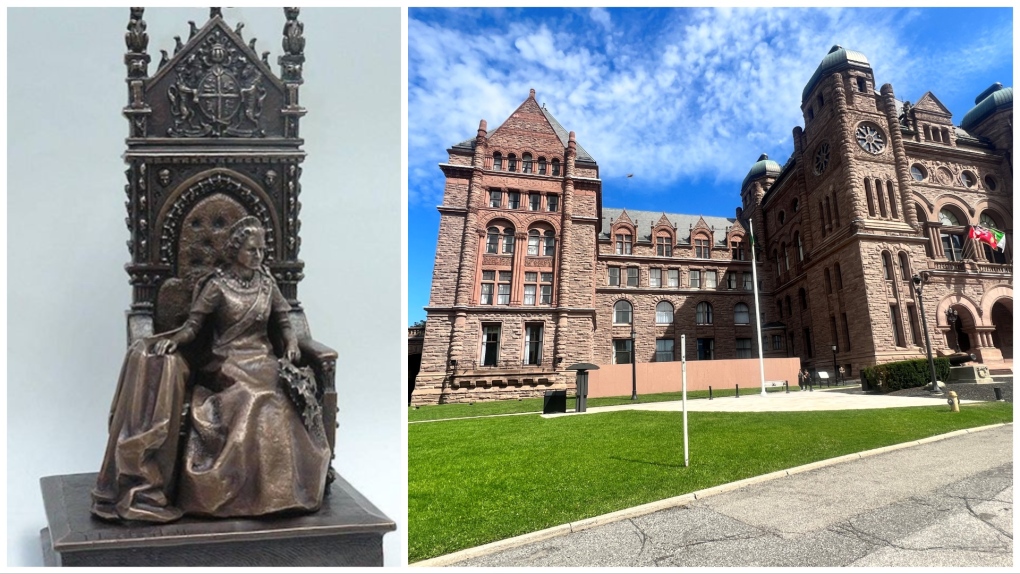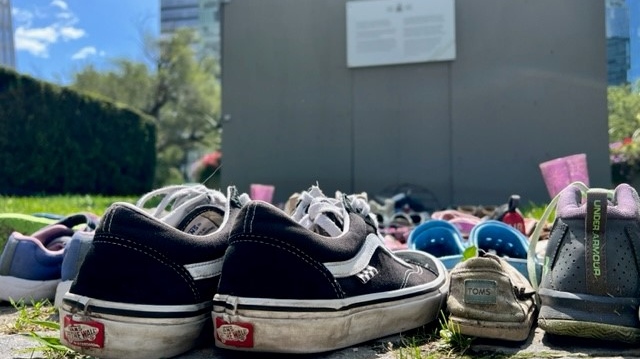Statue of Queen Elizabeth II to be installed at Ontario legislature by end of year
A new bronze statue of Queen Elizabeth II will soon be installed at the Ontario legislature.
Work has begun on the base of the piece at Queen’s Park, located on the south side of the building in front of the visitor welcome centre. Toronto residents won’t be able to see much yet – as the construction area is being blocked off by a wooden enclosure.
Government House Leader Paul Calandra’s office confirmed the costs for the project are anticipated to be up to $1.5 million. His office said they are optimistic the statue will be unveiled by the end of the year.
Speaking with CTV News Toronto, Calandra said the statue will honour the Queen’s “long service to Canada and to the province of Ontario.”
“It is a really impressive piece of work from the artist,” he said. “I think it will be a wonderful addition to Queen’s Park.”
- Download our app to get local alerts on your device
- Get the latest local updates right to your inbox
The project has been years in the making. First commissioned in 2016 after receiving the Queen’s approval, the statue is expected to depict the late-monarch at about 150 per cent life size.
“It's the Queen as she appeared when she spoke to Canadian Parliament in 1977,” Ontario artist Ruth Abernethy told CTV News Toronto.
Abernethy said the monarch was wearing a white gown with beadwork at the time of the speech and was holding maple leaves, “one for each province and three for each territory.”
“I added a cape to the dress because I felt that it was less static. I wanted a bit more animation in the portrait. And this [being] Canada, you know you want to feel that in the middle of a Canadian winter she could pull that round herself she needs to.”
She noted that the throne, which the Queen was sitting on, was surprisingly modest.
 A maquette of Queen Elizabeth II by Ruth Abernethy, taken from her website, is seen beside a photo of Queen's Park.
A maquette of Queen Elizabeth II by Ruth Abernethy, taken from her website, is seen beside a photo of Queen's Park.
The statue is being erected just over a year after Queen Elizabeth II died at the age of 96. She reigned for 70 years.
Abernethy noted she was not surprised by the delays in installing her work, and that when working with bronze she is used to holding the ”long view.”
She also said the piece “was always going to come with a lot of complexity.”
“If you go through history, it's not been simple ever. Anytime they ever put up Caesar or Queen Victoria or any leader of significance,” she said. “You can't imagine putting up something on this size and scale and having public silence. That is untenable.”
“My task is always to talk about the making of the work. Let my clients speak to the press about other aspects of it for their communities.”
The British monarchy has a complex history in Canada, particularly when it comes to the impact of colonization on Indigenous Peoples.
Over the last few years, statues of royalty, as well as those of former politicians, have been vandalized or torn down. In Kitchener, a statue of Queen Victoria has been vandalized five times in the last three years. Advocates have called for its removal due to its connection to Canada’s colonialist past.
At Queen’s Park, a prominent statue of Canada’s first Prime Minister, Sir John A. Macdonald, has been encased in a wooden box for years after several incidents of vandalism.
Dozens of small shoes can still be found near the enclosure, representing the Indigenous children who were killed at residential schools.
 Shoes are seen outside the enclosed statue of Prime Minister John A. Macdonald at Queen's Park. (Siobhan Morris)
Shoes are seen outside the enclosed statue of Prime Minister John A. Macdonald at Queen's Park. (Siobhan Morris)
It’s unclear what is happening with that statue. A nearby sign says the Speaker of the Legislative Assembly is “considering how the depictions of those histories in the monuments and statuary on the Assembly’s grounds can respect all of our diverse cultures and peoples.”
“Though we cannot change the history we have inherited, we can shape the history we wish to leave behind.”
In a statement to CTV News Toronto, Jeffrey Ansloos, an associate professor of Indigenous health and social policy at the University of Toronto, called the government’s decision to build the statue “unconscionable.”
'This statue is a celebration of a monarch whose governments have overseen endless violations of Indigenous Peoples' rights, and under whose present austerity is wreaking havoc on Canadians,” Ansloos wrote.
“I suspect, like statues before in throughout Ontario, like those commemorating the architects of Indian Residential Schools, the statue of the late Queen Elizabeth II will face a similar fate: it will be covered in red paint and eventually toppled.”
Meanwhile, Calandra says he believes the government can both celebrate the good in its history, while also acknowledging the parts that we may not be proud of. He also said he would support the idea of having a monument or structure on the legislative grounds that aknowledges the impact of residential schools.
"We shouldn’t hide from our past. I think the problem we are having right now is that we are afraid to do either."
CTVNews.ca Top Stories

Live election results: Harris calls Trump to congratulate him on election victory
Vice President Kamala Harris called Trump on Wednesday to congratulate him on his election victory.
Trump wins the White House in a political comeback rooted in appeals to frustrated voters
Donald Trump was elected the 47th president of the United States on Wednesday, an extraordinary comeback for a former president who refused to accept defeat four years ago, sparked a violent insurrection at the U.S. Capitol, was convicted of felony charges and survived two assassination attempts.
Read the full transcript of Donald Trump's victory speech
The former U.S. president and now president-elect addressed a crowd of supporters at his campaign headquarters in West Palm Beach, Fla., shortly after 2:30 a.m. EST, Wednesday morning.
'Canada will be absolutely fine': Justin Trudeau, his ministers and Pierre Poilievre congratulate Donald Trump
Canadian Prime Minister Justin Trudeau and members of his cabinet congratulated Donald Trump Wednesday morning on his second United States presidential election win, amid questions about how the federal government intends to navigate a second term.
4 ways in which Donald Trump's election was historic
Donald Trump's election victory was history-making in several respects, even as his defeat of U.S. Vice-President Kamala Harris prevented other firsts. She would have been the nation's first Black and South Asian woman to be president.
Who won the popular vote? U.S. election vote totals from the past 40 years
Donald Trump won the U.S. presidency on Tuesday, and as of Wednesday morning, was also ahead in the popular vote. Historically, though, the candidate with the most votes hasn’t always won the contest.
Kingston, Ont. doctor fighting OHIP clawback of $660K in pandemic vaccination payments
A Kingston doctor is in a dispute with the Ontario Ministry of Health, which is trying to clawback more than $600,000 in OHIP payments.
'How to move to Canada' surges on Google as U.S. wakes up to Donald Trump win
U.S. search engine queries about moving to Canada shot up Wednesday in the wake of Donald Trump’s decisive win in the presidential election.
Kamala Harris made a historic dash for the White House. Here's why she fell short.
It was a moment that encapsulated one of the biggest challenges facing U.S. Vice President Kamala Harris' campaign – which, in the end, proved insurmountable. A country crying out for change got a candidate who, at a crucial moment as more voters were tuning in, decided to soft-pedal the change she knew she represented.
































